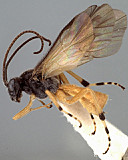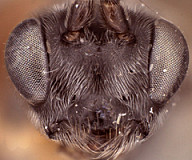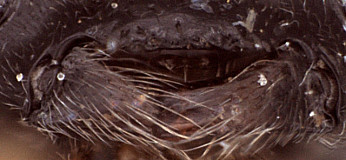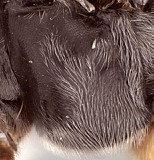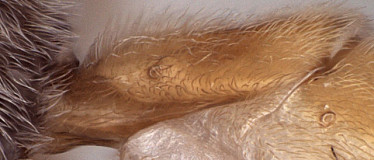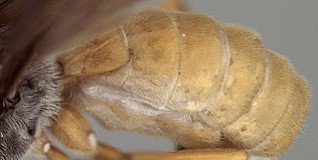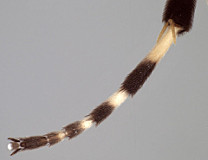Clypeus (Figs 2, 3) with ventral margin bluntly rounded, usually thicker medially; ventral margin evenly convex; distinctly punctate over ventral 0.3-0.4; epistomal sulcus sharp and distinctly impressed throughout; clypeus in profile weakly but distinctly protruding. Malar space distinct, at least half basal width of mandible; malar sulcus absent. Mandible (Fig 3) densely setose basally; weakly narrowing distally; dorsal tooth shorter and narrower than ventral tooth. Ocelli small, lateral ocellus shorter than distance between ocellus and eye. Maxillary palp shorter than head height; female and male antennae equal to or slightly shorter than body; first flagellomere with basal tyloid difficult to distinguish among dense setae. Hypostomal carina meeting occipital carina above base of mandible; occipital carina incomplete: absent middorsally. Head and mesosoma densely setose. Dorsal end of epicnemial carina distant from anterior margin of mesopleuron by about width of first flagellomere. Notaulus short but distinctly impressed basally, barely extending beyond basal declivity, not extending posterior to level of tegula. U-shaped groove between propodeum and metanotum present, but usually difficult to see in lateral view because of dense covering of setae; pleural carina complete, well-developed; propodeal carinae otherwise apparently absent in material examined but propodeum densely setose and therefore difficult to discern. Apical margin of mid tibia expanded into a distinct tooth similar to that of fore leg in both sexes; apical comb on posterior side of hind tibia absent; posterior hind tibial spur at least 7x longer than maximum width at base; tarsal claws simple. Fore wing areolet present, well-developed and nearly rectangular in the five specimens examined; Rs+2r arising from basal third of stigma. Hind wing with first abscissa of CU1 distinctly longer than 1cu-a. T1 relatively short, broadening gradually from base to apex, about 1.3-1.4 x longer than apical width; dorsal carinae weakly developed, broadly rounded, not extending posteriorad spiracle; basal depression at dorsal tendon attachment very deep; dorsal-lateral carina absent; glymma (Fig 7) deep, basal, extending medially into basal depression of dorsal tendon attachment. on each side meeting on the midline posterior to dorsal tendon attachment. T2 thyridium absent; laterotergites of T2 and T3 separated by creases. Ovipositor weakly down-turned, with very deep, broad, subapical notch, with portion distad notch small; ovipositor sheath straight, bluntly rounded apically. Male parameres broadly triangular, never attenuate posteriorly; aedeagus simple.
In his generic revision, Townes (1970 states that the propodeum is smooth or with longitudinal carinae more or less complete.

